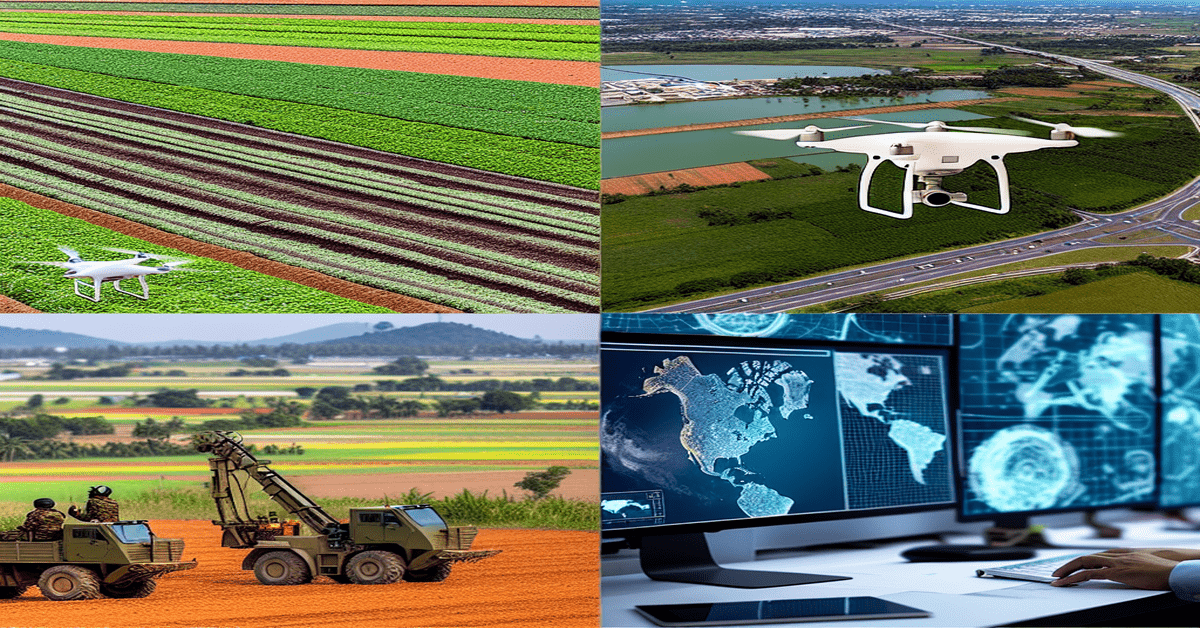Geospatial Analytics: Transforming Agriculture, Defense, and Infrastructure
In the rapidly evolving world of technology, geospatial analytics has emerged as a game-changer across various industries. From precision farming to military operations and infrastructure development, the applications of geospatial analytics are vast and transformative. As we delve into the intricacies of this cutting-edge technology, it becomes evident that the future holds immense growth opportunities for the geospatial analytics market.
A Booming Market: Projections and Key Players
According to recent market research, the global geospatial analytics market is poised for significant growth in the coming years. With a projected CAGR of **12.5% to 12.8%** from 2024 to 2031, the market is expected to reach a staggering value of **USD 364.34 billion** and beyond by 2031 [1][3][4]. This growth is driven by the increasing adoption of geospatial technologies across various sectors, as organizations recognize the immense potential of geospatial data in driving informed decision-making and optimizing operations.
The geospatial analytics market is dominated by several key players, including tech giants such as **Microsoft, Google, General Electric, SAP SE, Salesforce, Precisely, Oracle Corporation, RMSI, OmniSci, Inc., Maxar Technologies Inc., WS Atkins Limited, Hexagon AB, TomTom**, and **Trimble Inc.** [3]. These companies are at the forefront of innovation, constantly pushing the boundaries of what is possible with geospatial analytics.
Revolutionizing Agriculture: Precision Farming and Crop Optimization
One of the most promising applications of geospatial analytics lies in the agricultural sector. Precision farming, powered by geospatial data, has the potential to revolutionize the way we grow crops. By leveraging geospatial analytics, farmers can optimize resource usage, reduce waste, and improve crop yields. Geospatial data provides invaluable insights into soil health, weather patterns, and crop growth, enabling farmers to make data-driven decisions that maximize productivity and minimize environmental impact.
Crop yield prediction is another area where geospatial analytics shines. By analyzing historical data, weather patterns, and soil conditions, geospatial analytics can help farmers predict crop yields with remarkable accuracy. This information allows farmers to plan their harvests effectively, reduce waste, and optimize their supply chains.
Empowering Defense: Situational Awareness and Strategic Planning
In the defense sector, geospatial analytics plays a crucial role in enhancing situational awareness and supporting strategic planning. Military operations rely heavily on real-time intelligence about enemy movements, terrain analysis, and resource deployment. Geospatial analytics provides a comprehensive view of the battlefield, enabling military leaders to make informed decisions and optimize their strategies.
Surveillance and reconnaissance missions also benefit greatly from geospatial analytics. By analyzing satellite imagery, drone footage, and other geospatial data sources, military intelligence can identify potential threats, track enemy movements, and gather critical information to support mission planning and execution.
Transforming Infrastructure: Efficient Planning and Resource Allocation
Infrastructure development is another domain where geospatial analytics is making a significant impact. From road construction to urban planning, geospatial data helps in optimizing resource allocation, reducing costs, and minimizing environmental impact. By analyzing geospatial data, infrastructure planners can identify the most suitable locations for new projects, assess potential risks and challenges, and develop efficient construction strategies.
Geospatial analytics also plays a vital role in managing existing infrastructure. By monitoring the condition of roads, bridges, and other critical infrastructure, geospatial data can help identify areas in need of maintenance or repair. This proactive approach helps in preventing costly failures and ensuring the long-term sustainability of our infrastructure.
The Future of Geospatial Analytics: Opportunities and Challenges
As the geospatial analytics market continues to grow, it is essential to recognize the opportunities and challenges that lie ahead. The increasing availability of high-resolution satellite imagery, advancements in AI and machine learning, and the proliferation of IoT devices are all contributing to the rapid evolution of geospatial analytics.
However, with growth comes challenges. Data privacy and security concerns are becoming increasingly important as organizations collect and analyze vast amounts of geospatial data. Ensuring the responsible use of geospatial data while maintaining individual privacy rights will be a key focus area for the industry moving forward.
Another challenge lies in the integration of geospatial analytics with existing systems and workflows. Organizations must invest in the necessary infrastructure, talent, and processes to effectively leverage geospatial data and derive meaningful insights.
Conclusion: Embracing the Geospatial Revolution
The geospatial analytics market is on the cusp of a revolution, with immense growth opportunities across various industries. From agriculture to defense and infrastructure, the applications of geospatial analytics are transforming the way we live, work, and interact with our environment.
As we embrace this geospatial revolution, it is crucial for organizations to stay ahead of the curve. By investing in geospatial technologies, fostering innovation, and developing a skilled workforce, companies can position themselves for success in the rapidly evolving landscape of geospatial analytics.
The future is bright for geospatial analytics, and the possibilities are endless. As we continue to harness the power of geospatial data, we can expect to see groundbreaking advancements that will shape the course of industries and improve the lives of people around the world.
#GeospatialAnalytics #IndustryTransformation #DataDrivenDecisions
-> Original article and inspiration provided by LeadsProMax.aiDataM intelligence 4 Market Research LLP
-> Connect with one of our LeadsProMax.ai Strategists today at LeadsProMax.ai


